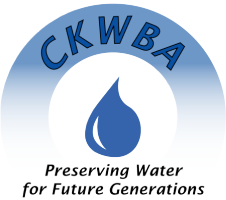
Follow @CKWBA
Home | FAQ | Board of Directors | Rules & Regulations | Charter | Banking Act | Current Activity | Conservation Component Map | Water Right Buyer & Seller Board | Bank Forms | Contact Us | GMD#5
Water Banking will promote water conservation and the wise use of the groundwater resources and provide increased flexibility for the water users within the banking area. BACKGROUND
CONSUMPTIVE USE IN WATER BANKING: The Water Banking Act requires a minimum of 10% water savings in consumptive use on all deposit/lease transactions. One might ask how that quantity would be determined since consumptive use is some portion of the actual water pumped. Since it is a complex issue, a regulation was adopted specific to water banking that addresses the consumptive use portion of a person’s water use. CKWBA shall calculate the average water use for years 1987 through 1996. This is the representative past period that the bank will be comparing all water savings. CONSERVATION COMPONENT: A conservation component is calculated to meet the requirement of the 10% savings in consumptive use. The conservation component will be based on the following hydrologic parameters: 1) decline since predevelopment 2) total saturated thickness 3) number of wells within 2-miles of well, and 4) distance from a stream. Conservation components can vary from 10 to 16 percent depending where the well is located for the proposed for lease. Only leases are subject to a conservation component. DEPOSITS: The objective of water banking is to allow water users who wish to sell (deposit) their water on an annual basis up to five years so others can lease it. The depositor sets a price for the water and it is then made available for lease by another user. Anyone wishing to sign up to deposit their water must do so on or before April 1 of the year in which the deposit will be made. A water right, or a portion of a water right, may be deposited only in increments of full calendar years. A water right shall not be eligible for deposit if water use occurred under the water right, or a portion of the water right, at any time from January 1 through March 31 of the year in which the deposit will be made. When the term for the deposit expires, the full annual amount of water is again available to the original water right holder. Water rights on deposit in the bank constitutes due and sufficient cause for non-use. LEASES: A person may lease water that has been deposited in the Bank. Leases may be allowed up to the length of the Bank Charter. Water must be leased and used in the same hydrologic unit of the water deposited.
BULLETIN BOARD: A bulletin board is established to post deposits, leases and completed transactions. SAVINGS ACCOUNTS Savings Accounts are also be offered through the Water Bank. These accounts allow water users to carryover a portion of unused water from one year to the next. The amount that can be carried over is 25% of any unused water up to the authorized amount. At the end of each year, 10% is reduced for conservation purposes. There can not be multiple savings accounts for any point of diversion. Water users must also sign up for the savings account program by December 1 of the year preceding the year to begin using the account. APPLICATIONS / CONTRACTS Each person proposing to deposit or lease water must complete an application for contract with the Association. Each person proposing to use the savings account option must enter into a contract with the Association prior to the establishment of an account. A contract to lease water or use water from a savings account cannot be exercised without first obtaining a term permit from the Division of Water Resources. FEES: The Central Kansas Water Bank Association is a private, not-for-profit entity separate from GMD5. The Bank can only operate under a fee based system. The CKWBA must reimburse the State and GMD5 for certain administrative costs. Contact the District office for a current fee schedule. SEVEN YEAR REVIEW: Every seven years, the CKWBA charter is reviewed by an independent panel to determine if conservation goals have been met. That review will also consider the bank’s effect on the groundwater supply and other water right holders. |